Polar Bears and Siberian Tigers are very different creatures, living in different corners of the world.
Polar Bears roam the icy expanses of the Arctic, depending on sea ice to hunt primarily seals. Their bodies are adapted to the cold, with a thick layer of blubber and dense fur. On the other hand, Siberian Tigers live in the dense forests of eastern Russia. These big cats have powerful, muscular bodies and distinctive orange coats with black stripes. Their diet is diverse; they hunt everything from deer to smaller prey.
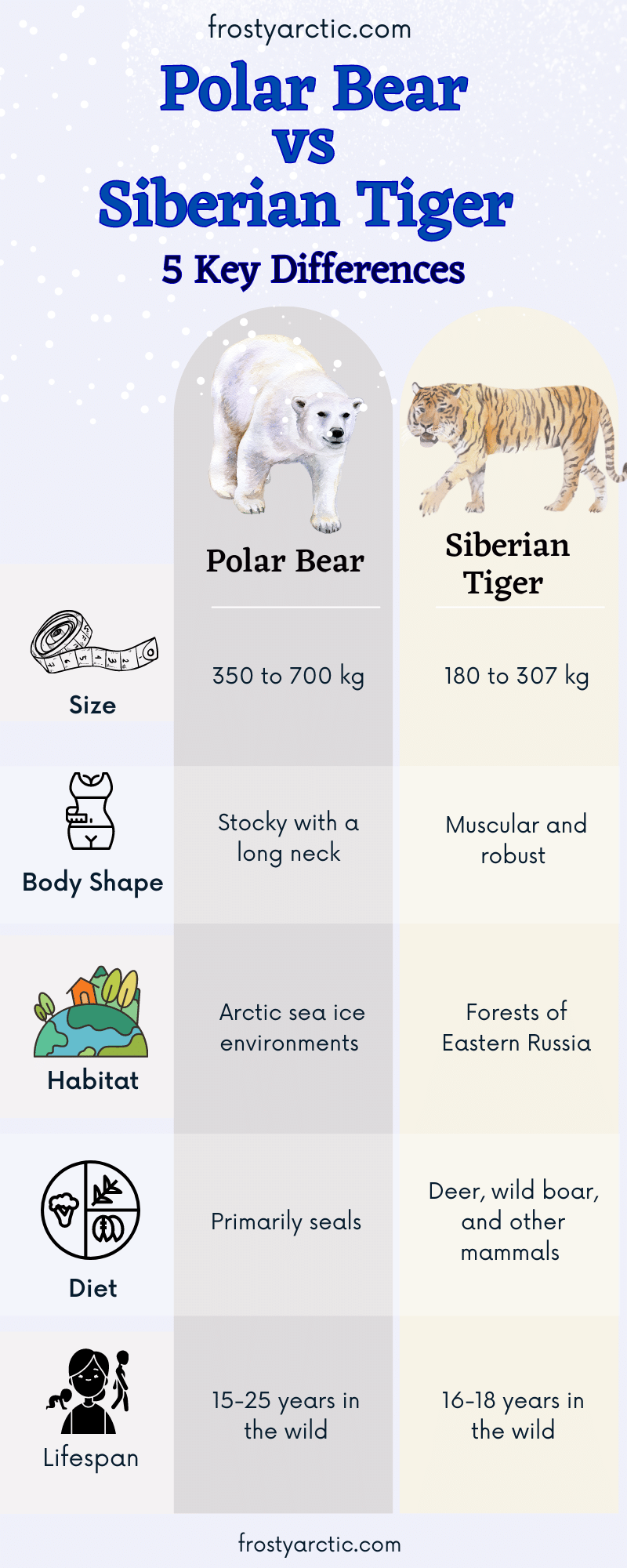
But hang on! That’s just the tip of the iceberg. Continue reading, and you’ll uncover the intricate details of their habitats, behaviors, and challenges. Journey with us as we explore the mesmerizing tales of these two giants. We promise every fact will be a step deeper into wonder!
Polar Bear vs Siberian Tiger – A Quick Comparison
| Feature | Polar Bear | Siberian Tiger |
| Scientific Name | Ursus maritimus | Panthera tigris altaica |
| Family | Ursidae | Felidae |
| Body Shape | Stocky with a long neck | Muscular and robust |
| Size (Male) | 350 to 700 kg | 180 to 307 kg |
| Diet | Primarily seals | Deer, wild boar, and other mammals |
| Habitat | Arctic sea ice environments | Forests of Eastern Russia |
| Social Behavior | Mostly solitary except during mating season or mother with cubs | Solitary except during mating season or mother with cubs |
| Lifespan | 15-25 years in the wild | 16-18 years in the wild |
| Gestation Period | About 195-265 days | Approximately 104 days |
| IUCN Status | Vulnerable | Endangered |
Polar Bear vs. Siberian Tiger – What Are the Key Differences?
While hailing from different terrains, polar Bears and Siberian Tigers share the title of apex predators in their respective habitats.
Both these majestic creatures have thick coats to protect them from the cold, are primarily solitary by nature, and are fiercely protective mothers. They’ve adapted to become efficient hunters in their domains for thousands of years.
However, beyond these shared characteristics, polar bears and Siberian tigers have a plethora of unique features and behaviors sculpted by their distinct environments. Let’s dig deep to explore these fascinating contrasts.
1. Taxonomy and Scientific Classification
Both the polar bear and the Siberian tiger share the same domain, kingdom, phylum, and class. However, their paths diverge at the order, family, genus, and species levels.
Polar Bear
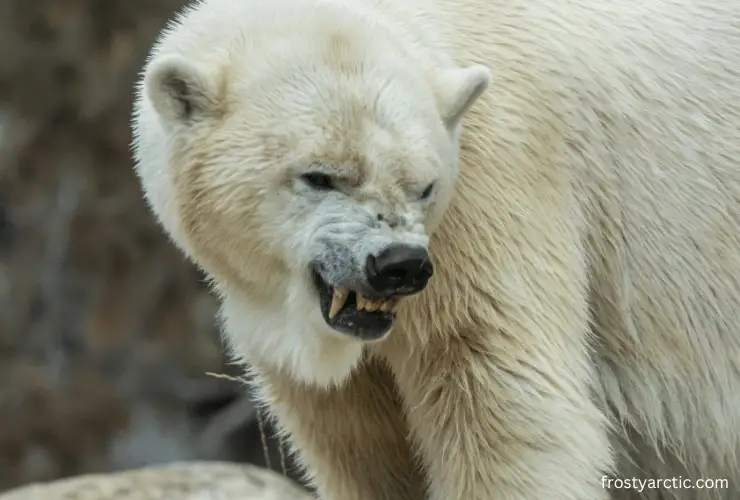
The polar bear, often called the sea bear or ice bear, is scientifically named Ursus maritimus. It belongs to the Ursidae family, which houses all bear species. Its classification is within the Ursus genus.
Polar bears are members of the Carnivora order, given their predominantly meat-eating diet. From a genetic standpoint, polar bears and brown bears share a common ancestry. They are believed to have diverged about 500,000 to 600,000 years ago. ~Nature
Siberian Tiger
The Siberian tiger, also called the Amur tiger, goes by the scientific name Panthera tigris altaica. This magnificent creature is part of the Felidae family, which includes all big and small cats.
It’s classified under the genus Panthera, alongside lions, leopards, and jaguars. Siberian tigers fall under the Carnivora order due to their carnivorous diet. ~International Environment Library Consortium
| Taxon | Polar Bear | Siberian Tiger |
| Kingdom | Animalia | Animalia |
| Phylum | Chordata | Chordata |
| Class | Mammalia | Mammalia |
| Order | Carnivora | Carnivora |
| Family | Ursidae | Felidae |
| Genus | Ursus | Panthera |
| Species | Ursus maritimus | Panthera tigris altaica |
2. Habitat and Distribution
Both polar bears and Siberian tigers hail from vastly different corners of the world, adapted to unique climates and terrains.
Polar Bear
The polar bear belongs to the Arctic world. Here’s a closer look at its habitat:
- Continent: Primarily North America, though they can also be found in parts of Europe and Asia.
- Countries: Predominantly Canada (which hosts most of the global population), but also Greenland, Norway, Russia, and the U.S. (specifically Alaska).
- Habitat: Sea ice lands in the circumpolar Arctic.
The Arctic presents a bitterly cold climate, with temperatures often descending below -40 degrees Fahrenheit. Such extreme cold, however, is what polar bears are specially adapted for. ~World Wildlife Fund
Siberian Tiger
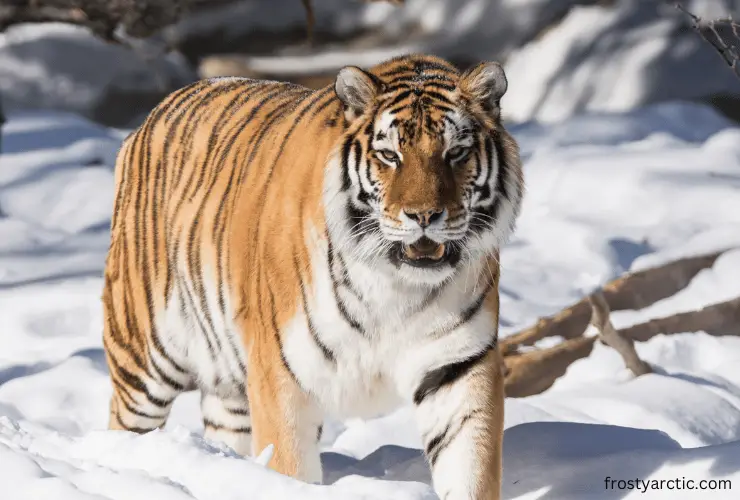
The Siberian tiger, on the other hand, reigns in the dense forests of Eastern Russia. Here’s a snapshot of their habitat:
- Continent: Primarily Asia.
- Countries: Predominantly Russia, especially the Far East, with some populations spilling into China and possibly North Korea.
- Habitat: Cold, dense forests in the Russian Far East and Northeast China.
Unlike the vast, open ice expanses that polar bears traverse, Siberian tigers thrive in forested regions, using the dense trees as cover for stalking prey.
The harsh winters and snowy landscapes of their habitat starkly contrast with the tropical environments other tiger subspecies inhabit. But, with their thick fur and large body size, Siberian tigers are well-equipped for the cold.
| Attribute | Polar Bear | Siberian Tiger |
| Continent | Primarily North America | Asia |
| Countries | Canada, Greenland, Norway, Russia, USA (Alaska) | Russia (Far East), China, and possibly North Korea |
| Habitat | Sea ice environments in the circumpolar Arctic | Cold, dense Forests in Russian Far East & Northeast China |
3. Physical Appearance
The polar bear and Siberian tiger have distinct physical attributes essential for their survival in their respective habitats.
Polar Bear
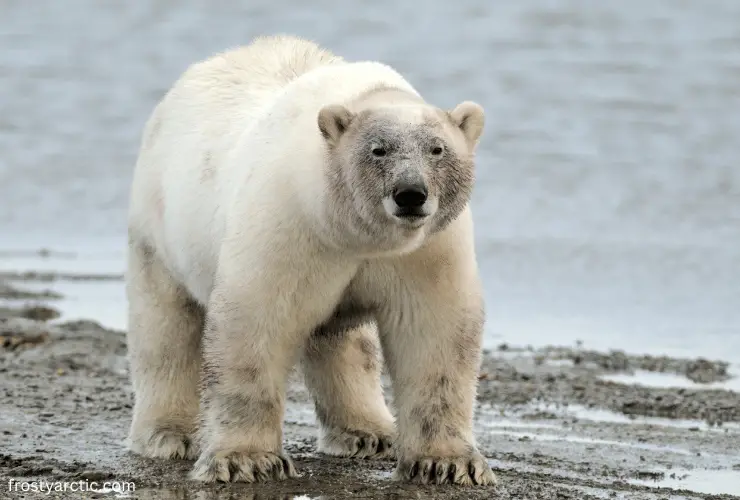
- Color: Predominantly white, which provides excellent camouflage against the snow and ice.
- Coat: Dense and water-repellent, this coat consists of a thick layer of blubber beneath for insulation against the cold.
- Eyes: Dark, which stands out against its white fur, helping them spot prey and mates in the vast Arctic expanse.
- Size: Adult males typically weigh between 350 and 700 kg, with females being about half that size.
- Body Shape: Stocky build with a long neck and relatively small head, which helps when hunting seals – their primary prey.
- Paws: Large and slightly webbed, aiding in swimming and distributing weight on delicate ice, as described by the Alaska Department of Fish and Game.
Siberian Tiger
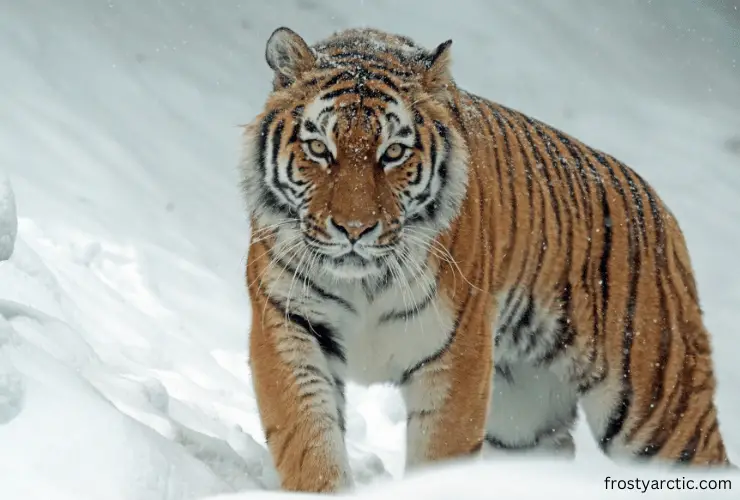
- Color: Deep orange coat with dark stripes, providing perfect camouflage amid the thick underbrush and against the snow in winter.
- Coat: Thick and lush, especially in the winter, giving them the insulation they need against the cold Siberian temperatures.
- Eyes: Amber to yellowish, with an intense gaze that’s symbolic of all big cats.
- Size: They are the largest of the tiger subspecies. Males can weigh between 180 to 307 kg, though some can exceed this, while females are generally lighter.
- Body Shape: Muscular and agile with a robust build, built for stalking and overpowering prey.
- Paws: Large with retractable claws, perfect for gripping onto prey. ~Source
| Attribute | Polar Bear | Siberian Tiger |
| Color | White | Deep orange with dark stripes |
| Coat | Dense, water-repellent with thick blubber beneath | Thick and lush |
| Eyes | Dark | Amber to yellowish |
| Size (Adult Males) | 350 to 700 kg | 180 to 307 kg |
| Body Shape | Stocky with a long neck and small head | Muscular, agile, robust |
| Paws | Large and slightly webbed | Large with retractable claws |
4. Diet and Feeding Habits
Just as polar bears and Siberian tigers inhabit quite different habitats, they also have very different diets and feeding habits specially adapted to their disparate environments.
Polar Bear
- Primary Diet: Seals, especially the ringed and bearded seals, are the cornerstone of a polar bear’s diet.
- Hunting Technique: They often use a sit-and-wait technique, lingering near seal breathing holes to snatch them as they emerge. At other times, they’ll stalk seals resting on the ice, using their white coat as camouflage.
- Feeding Pattern: Polar bears primarily consume the high-fat blubber of seals, which provides them with the energy they require to survive in their freezing habitat. They can eat 45 kg of blubber in a single meal.
- Dietary Variations: While seals are their primary prey, polar bears are known to consume carcasses of stranded whales, birds, and occasionally vegetation when other food sources are scarce.
Siberian Tiger
- Primary Diet: The main prey of Siberian tigers consists of large ungulates like wild boars, deer (such as roe, red, and sika deer), and elk. However, they’re also known to take smaller animals and even fish.
- Hunting Technique: These tigers are ambush predators. They use the dense underbrush and their striped coat to camouflage themselves, stalking close to their prey before launching a quick and powerful attack.
- Feeding Pattern: A Siberian tiger can consume up to 40 kg of meat in one go after a successful hunt. They might not eat again for several days.
- Dietary Variations: When large prey is scarce, these tigers can feed on smaller animals like rabbits, pikas, and fish. They’ve also been known to prey on brown bears in certain regions. ~Source
| Attribute | Polar Bear | Siberian Tiger |
| Primary Diet | Seals (ringed and bearded) | Large ungulates (boars, deer, elk) |
| Hunting Technique | Sit-and-wait; stalking | Ambush; stealthy stalking |
| Feeding Pattern | Eats mainly seal blubber | Consumes whole prey |
| Dietary Variations | Whales, birds, some vegetation | Smaller animals, fish, occasionally brown bears |
5. Social Behavior
Both these species exhibit unique social behaviors that are adapted to their respective environments.
Polar Bear
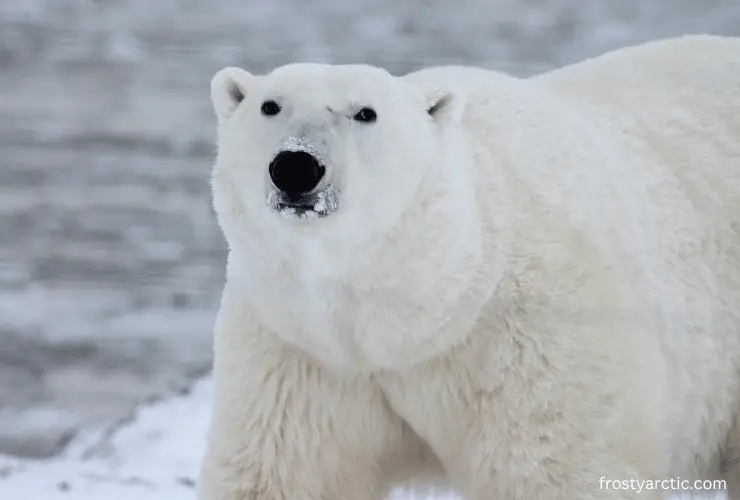
- Solitude: Adult polar bears are largely solitary, particularly males. They prefer roaming vast distances alone, especially when not in mating season.
- Mating Behavior: Males might engage in fierce battles for the right to mate with a female during breeding seasons. After mating, males move on, and the females raise the cubs alone.
- Mother-Cub Bond: Mothers share a strong bond with their cubs, nurturing them for about 2.5 years and teaching them essential survival skills.
- Social Interactions: While not overly social, polar bears sometimes form temporary groupings, especially in places with abundant food sources, like whale carcasses. ~Source
Siberian Tiger
- Territoriality: Siberian tigers are fiercely territorial. Both males and females mark and defend their territories from other tigers.
- Solitude: Much like polar bears, adult Siberian tigers prefer a solitary life. Most of their interactions with other tigers revolve around mating or territorial disputes.
- Mating Behavior: Males may roam searching for a mate, and the bond is short-lived after mating. The responsibility of rearing the cubs lies solely with the mother.
- Mother-Cub Bond: Tiger cubs stay with their mother for about two to three years, during which she teaches them how to hunt and survive. ~National Geographic
| Attribute | Polar Bear | Siberian Tiger |
| General Nature | Solitary | Solitary & Territorial |
| Mating Behavior | Males fight for females, brief bonding. | Brief bonding, then separate |
| Parenting | Mother raises cubs alone. | Mother raises cubs alone. |
| Social Groupings | Temporary, especially around abundant food | Rare, mostly around mating or territorial confrontations |
6. Reproduction and Lifecycle
The reproductive strategies and lifecycles of these magnificent creatures are tailored to their unique environments and challenges.
Polar Bear
- Mating Season: Typically occurs from March through May.
- Gestation: After mating, polar bears experience delayed implantation, where the fertilized egg waits to implant until conditions are optimal. Actual gestation lasts about 195-265 days.
- Cub Birth: Between November and February, females give birth, typically to twins, in a den made of snow.
- Cub Care: Cubs are born blind, deaf, and extremely vulnerable. They rely on their mother’s milk and remain in the den for several months before venturing outside in the spring.
- Lifespan: On average, wild polar bears live to be about 15-25 years old.
Siberian Tiger

- Mating Season: Typically occurs fromDecember to January.
- Gestation: A female Siberian tiger’s gestation period lasts about 3 to 3.5 months.
- Cub Birth: Females give birth to a litter of 2-4 cubs, usually in a secluded location like a cave or dense vegetation.
- Cub Care: Tiger cubs are born blind and are completely dependent on their mother. They start to follow her on hunts at around 6 months of age.
- Lifespan: In the wild, Siberian tigers typically live for 16-18 years. ~Source
| Attribute | Polar Bear | Siberian Tiger |
| Mating Season | March to May | Mostly between December to January |
| Gestation | 195-265 days (with delayed implantation) | 3 to 3.5 months |
| Cub Birth | 1-3 cubs, typically twins | 3-4 cubs |
| Cub Upbringing | Cubs emerge in spring, stay for ~2.5 years | Cubs hunt at 6 months, leave at 2-3 years |
| Lifespan | 15-25 years in the wild | 16-18 years in the wild |
7. Natural Predators
Both the polar bear and the Siberian tiger sit atop their respective food chains, still their dominance doesn’t make them entirely invulnerable.
Polar Bear
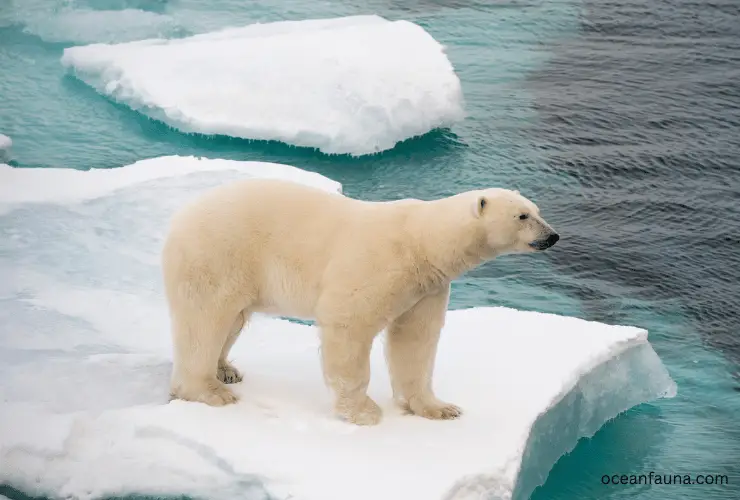
Polar bears typically have no natural predators. Their sheer size, strength, and the remoteness of their habitat ensure they remain the apex predator of their environment.
Young cubs, however, are vulnerable. They can fall prey to adult male polar bears, Arctic wolves, or even other predatory animals if they stray far from their mother, as outlined in a COSEWIC report.
Siberian Tiger
Similar to polar bears, adult Siberian tigers have no natural predators. Their formidable size and prowess ensure they dominate their habitat.
Cubs are at risk from a variety of threats. Adult male tigers, bears, and even large predatory birds can pose a threat to young, unsupervised cubs. ~Source
| Attribute | Polar Bear | Siberian Tiger |
| Adult Predators | None (apex predator) | None (apex predator) |
| Young’s Predators | Adult male polar bears, Arctic wolves | Adult male tigers, bears, large predatory birds |
8. Defense Mechanism
The strategies each species employs to defend themselves also differ, shaped by the challenges of their environments.
Polar Bear
- Size and Strength: A full-grown polar bear is a formidable creature. Its sheer size and strength are often enough to deter any potential threats.
- Sharp Claws: Their strong, sharp claws, which they usually use to catch seals, can also serve as potent defensive tools.
- Teeth and Jaws: Powerful jaws combined with sharp canine teeth can deliver a deadly bite.
- Camouflage: Their white fur blends with the icy surroundings, providing an advantage against potential threats.
- Swimming: Polar bears are excellent swimmers, and they can use water as a means to escape from land-based threats. ~Source
Siberian Tiger
- Camouflage: The striped pattern on a Siberian tiger’s coat helps it blend seamlessly into the tall grasses and the dappled light of the forest, allowing it to avoid confrontations.
- Speed and Agility: Tigers are incredibly fast and agile, capable of escaping threats or confronting them head-on.
- Sharp Claws and Teeth: Like the polar bear, the tiger’s claws and teeth are formidable weapons. Their retractable claws can deliver powerful swipes, while their strong jaws and sharp teeth can inflict serious injuries.
- Roaring: A Siberian tiger’s roar, which can be heard up to 3 km away, can deter potential threats.
| Attribute | Polar Bear | Siberian Tiger |
| Camouflage | White fur for icy surroundings | Striped pattern for grasses and forest |
| Speed/Agility | Excellent swimmer | Fast and agile runner |
| Claws and Teeth | Sharp claws and powerful jaws | Retractable sharp claws and strong jaws |
| Additional Mechanisms | Size and strength | Roaring |
9. Interaction With Humans
Both the polar bear and Siberian tiger have unique interactions with humans.
Polar Bear
- Indigenous Cultures: For centuries, indigenous peoples of the Arctic have held polar bears in high esteem. These bears feature prominently in their myths, legends, and even hunting practices.
- Conflicts: As climate change shrinks the sea ice, polar bears are forced to travel farther inland in search of food. This has led to increased encounters with human settlements and, occasionally, conflicts.
- Tourism: Polar bear tourism, especially in places like Churchill, Canada, is booming. However, strict guidelines are in place to ensure the safety of both humans and bears.
Siberian Tiger
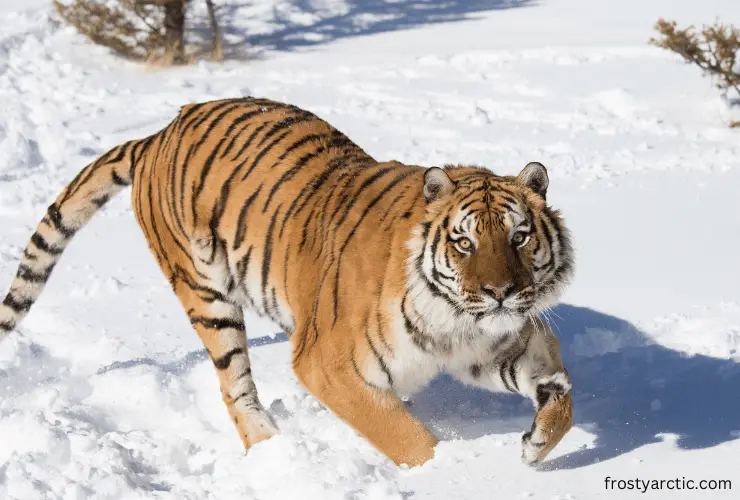
- Reverence: In many Asian cultures, the tiger symbolizes strength, power, and grace. They’ve inspired countless myths and folklore.
- Conflict: As human populations expand and forests shrink, encounters between tigers and humans, especially in villages bordering forests, have increased. Sometimes these encounters can be fatal for both parties.
- Poaching: Siberian tigers have been historically hunted for their fur and body parts, which are used in traditional medicines.
| Attribute | Polar Bear | Siberian Tiger |
| Cultural Significance | Important in indigenous Arctic myths and legends | Symbol of strength in many Asian cultures |
| Conflict | Increasing due to climate change-induced habitat loss | Rising with forest shrinkage and human encroachment |
| Human Uses | Tourism | Historically hunted for fur and body parts |
10. Threats and Conservation Status
Both the polar bear and the Siberian tiger face significant threats from human actions. However, the nature of these threats diverges due to their distinct habitats.
Polar Bear
The most significant threat to polar bears is the melting of the sea ice due to climate change. Bio-accumulation of chemicals like PCBs, industrial activities in the Arctic, and overharvesting threaten the polar bear.
Per the IUCN, the polar bear is listed as ‘Vulnerable.’
Siberian Tiger
The population of the Siberian tiger is in danger because of habitat Loss due to deforestation. It also faces threats from poaching for its fur, bones, and other body parts and overhunting.
The IUCN lists the Siberian tiger as ‘Endangered.’
| Attribute | Polar Bear | Siberian Tiger |
| Main Threat | Climate Change leading to sea ice loss | Habitat loss due to deforestation and poaching |
| Secondary Threats | Pollution, oil and gas development, overharvesting | Human-tiger conflicts, reduction in prey base |
| Conservation Status | Vulnerable | Endangered |
Who Would Win the Battle: Polar Bear vs Siberian Tiger?
Both the Polar Bear and the Siberian Tiger hold the crown as apex predators in their native habitats, but they have different strengths.
Polar Bears, the kings of the Arctic, have an impressive size advantage. Like their size, their bite force is significant, estimated to be around 1,200 psi. Furthermore, their muscular build and large paws, adept for swimming and walking on ice, offer immense strength and gripping ability.
On the other hand, the Siberian Tiger may be smaller than polar bears. But, they compensate with swiftness and sharp retractable claws, perfect for catching prey and climbing trees. They have a bite force of approximately 1,050 psi.
Tigers also ambush their prey, using their stripes as camouflage in the dense forest undergrowth.
One of the tiger’s most notable advantages is its agility. The Siberian Tiger can reach speeds up to 60 miles per hour in short bursts. This means the tiger would likely outrun the bear in an open-ground chase.
However, in a swimming contest, the polar bear, with its webbed toes and sturdy paddling skills, would undoubtedly have the upper hand.
So, who would come out on top if they were to clash? It’s truly situational. A polar bear’s natural strength and size might make it dominant on ice or in water. However, the Siberian Tiger’s agility, speed, and ambush skills could prove pivotal in dense forests or open terrains.
Watch this video:
Wrapping Up
So, are Polar Bear and Siberian Tigers the same? Absolutely not! While both are iconic symbols of power in their respective habitats, they are products of entirely different ecosystems.
Polar Bears, with their love for cold and reliance on sea ice, are masters of the Arctic. In contrast, Siberian Tigers, with their striking stripes and agility, rule the dense forests of eastern Russia.
That concludes our face-off between a polar bear and a Siberian tiger. Our planet is a treasure trove of stories, and we can’t wait to share more with you. Until next time!

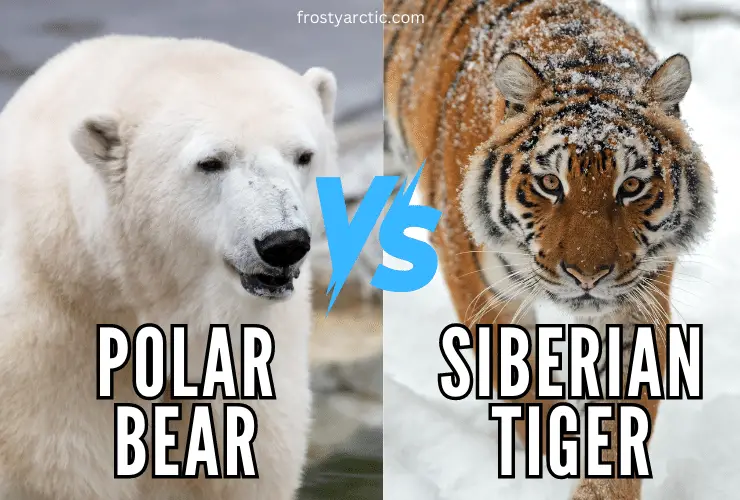

3 thoughts on “Polar Bear vs Siberian Tiger: Who Would Win a Fight?”